Welshpool is a market town situated in the historic county of Montgomeryshire, some four miles from the Wales – England, near the River Severn. The town lies in a prominent position along the main road from Newtown to Oswestry. The community includes Cloddiau and Pool Quay, and incorporates the fine Powis Castle and its estate, which lie just to the south. The men and women of the town and surrounding area who fell during both World Wars are commemorated on the Welshpool and District War Memorial, which is situated in a memorial garden along a steep flight of steps running from Church Street to the grounds of St. Mary’s Church, in a prominent position overlooking the town. The memorial takes the form of a series of sixteen tablets, set into a semi-circular wall, which curves around an elaborately carved lantern cross. This page commemorates the fallen of the town during World War Two.
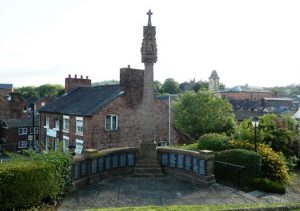
World War Two, 1939-1945
Richard Henry Allen, Fusilier, 4193131, Royal Welch Fusiliers. Richard was born in 1918, the son of Thomas Allen and Margaret Ellen Allen (nee Bason) of 5, Red Lion Passage, Welshpool. He was already serving with the 7th Battalion, Royal Welch Fusiliers, the local Territorial Army infantry battalion, when war erupted, but volunteered to serve with the newly formed No.2 Independent Company, a precursor to the army Commandos, which had been formed from volunteers from the 53rd (Welsh) Division. During the early weeks of 1940, the British had been making plans for a campaign in Norway, to support Finland in the Winter War against Russia, who at the time were Allied to Germany. When the Finns capitulated on 12 March 1940, the troops assigned to the operation were instead sent to France however, following the invasion of Norway by the Germans on 9 April, the British raised ten Special Companies, from TA Divisions, to form raiding parties, one of which being No.2 Independent Company. The Company landed at Bodø, south of Narvik as part of ‘Scissorforce’ on 14 May and immediately began operations against the Germans. Richard was killed during an action on 26 May 1940, just prior to the force being evacuated to Scotland. The 21-year-old is buried in Saltdal Main Churchyard, Norway, one of two Welshpool men killed in the same action.
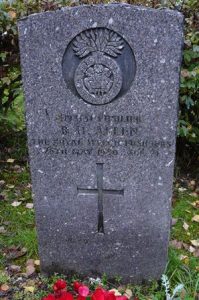
George Blewitt, Sapper, 14670463, Royal Engineers. George was born on 7 November 1922, the son of Harold Midwinter Blewitt and Elsie Blewitt (nee Paddock), of 2, Pentrefelin Terrace, Welshpool. He worked as a wood machinist prior to the war. George enlisted into the Royal Engineers and was posted to 1048 Port Operating Company, Royal Engineers. George probably moved to Normandy just after the D-Day landings with his Company, to assist in the landing of men and materials vital for the campaign to break-out from the Normandy Beachhead. He was one of eleven men of his Company killed on 3 August 1944. The 21-year-old has no known grave and is commemorated on the Bayeux Memorial, France.
Thomas Henry Richard Cambray, Corporal, 4194867, Royal Welch Fusiliers. Thomas was born in the Wirral in 1912, the son of Thomas Henry Eyeles Cambray and Rosa Emily Cambray (nee Richards). His mother was from Welshpool, and within a short time of Thomas’ birth, the family moved back to the town. Thomas married Sybil Frances Mary Evans, a Parlour Maid at Powis Castle, at Welshpool in 1939 and the couple set up home at Park House, Powis Castle Park. He was already serving with the 7th Battalion, Royal Welch Fusiliers when war erupted, but was posted to the 10th Battalion, Royal Welch Fusiliers, a ‘second line’ or ‘home service’ battalion, which was attached to the 115th (Royal Welch Fusiliers) Brigade, 38th (Welsh) Division, a 2nd Line duplicate of the 53rd (Welsh) Division. Thomas died on active service at Ince, Lancashire on 2 October 1940. The body of the 28-year-old was brought home and he was buried in Christ Church Churchyard, Welshpool five days later.
Albert Edward Cerrone, Private, 4531766, West Yorkshire Regiment (Prince of Wales’s Own). Albert was born in Sheffield in 1904, the son of Vincent Cerrone, an Italian migrant, and Martha Annie Cerrone (nee Thomason), who had been born in Swansea. By the time that war broke out, Albert was living in High Street, Welshpool and he married Dorothy May Sankey in the town early in 1940. Albert served throughout the war with a battalion of the West Yorkshire Regiment (Prince of Wales’s Own), but little is known of his military service. He died at Welshpool Hospital on 2 June 1945, aged 40. Albert was buried in St. Mary’s Churchyard, Welshpool four days later.
Jack Chester, Sergeant, 621389, Royal Air Force. Jack was born in Eccles, Lancashire in 1921, the son of William Chester and Jenny Chester (nee Morris). His father died in 1925 and his mother returned to her native Welshpool with young Jack. She then married Charles Edward Gamble on 9 June 1928 and the couple set up home at 39, Lledan Crescent, Welshpool. Jack enlisted into the Royal Air Force as a young man and was posted to 220 Squadron, RAF, which was a Coastal Command unit, based at RAF Thornaby, as part of No. 18 Group. In November 1939, the squadron converted to Lockheed Hudson’s and began a new role, carrying out anti-shipping missions and became operational in the North Sea, from May 1940 onwards. On 16 January 1941 Jack was flying aboard Lockheed Hudson I, Serial P5151 on a mission over the North Sea when it lost power and ditched into the sea off Redcar. Jack and his three fellow crewmen drowned, and their bodies were never recovered. Jack was just 19 years old when he died that day and is commemorated on the Runnymede Memorial, Surrey.
David Oswald Davies, Sergeant, 1392889, Royal Air Force Volunteer Reserve. David was born on 3 August 1923, the son of Evan Oswald Davies and Margaret Ann Davies (nee Edwards), of 15, St. Mary’s Place, Welshpool. He worked as an Estate Agents Valuer prior to the war. David enlisted into the Royal Air Force Volunteer Reserve and trained as an Air Gunner before being posted to 207 Squadron, Royal Air Force. The squadron was operating as an Operational Training Unit when was broke out, but in November 1940 re-formed at RAF Waddington as part of Bomber Command’s No. 5 Group, initially equipped with the Avro Manchester. The squadron later moved to RAF Bottesford, where the Manchester’s were replaced by Avro Lancaster in March 1942. The squadron was then forced to relocate to RAF Langar on 21 September, but in October 1943, the squadron moved to the newly opened RAF Spilsby bomber station. On 23 December 1943 David took off from Spilsby aboard Avro Lancaster III, Serial DV188, which formed part of a huge bomber force despatched to bomb strategic targets in Berlin. The Lancaster was intercepted and shot down by a German night fighter shortly after leaving the target area, crashing at Luckenwalde, some 30 miles south of Berlin. David was the sole casualty during the crash, as his fellow crewmen appear to have parachuted to safety and were taken prisoners of war. David was 20 years old when he was killed that night and is commemorated on the Runnymede Memorial, Surrey.
William Andrew Eccleston, Sapper, 1885055, Royal Engineers. William was born at Oswestry on 30 October 1911, the son of Frederick Eccleston and Sarah Eccleston (nee Jones). The family then moved to Stockton House, on the Powis Castle Estate, where Frederick had gained the position of Head Gamekeeper. William worked as an Ordnance Surveyor at Surbiton, Surrey prior to the war. With his experience in mapping, upon his enlistment into the Royal Engineers he was posted to the 512 Army Field Survey Company, Royal Engineers and was sent to North Africa with his unit. The unit was kept busy following its arrival, as it was initially tasked with mapping the area between the towns of Sallum in north-western Egypt and Tobruk in north-eastern Libya. The company drew up a series of detailed maps, covering the boundaries of the countries, the Mediterranean Sea coastline, capes and anchorages, populated places, palisade areas around Tobruk and Bardia, roads and tracks, telegraph line, graves, tombs, forts, water sources, vegetation, and terrain features, with the relief shown by contours and spot heights. William was killed in Egypt on 25 January 1942, just days after the launching of Rommel’s second offensive. The 30-year-old is buried in Heliopolis War Cemetery, Egypt.
James Edwin Ellis, Sergeant, 1410921, Royal Air Force Volunteer Reserve. James was born in 1921, the son of Percy Alfred Ellis and Martha Jane Ellis (nee Lewis), of 37, Rose Cottage, Welshpool. He enlisted into the Royal Air Force Volunteer Reserve soon after the outbreak of war and after training as a Wireless Operator, was posted to 49 Squadron, Royal Air Force. The squadron was the first operational unit to be equipped with the Handley Page Hampden and carried out the attack on the Dortmund-Ems Canal on 12 August 1940. In 1942 the squadron converted to Avro Manchester’s, then to Avro Lancaster’s, and in October led No.5 Group’s epic dusk attack on the Schneider armament and locomotive works at Le Creusot. In 1943 the squadron took part in the famous raid on Peenemunde, the V-1 rocket base. On 19 February 1944 James took off from RAF Fiskerton aboard Avro Lancaster III, Serial JB469, which had been despatched as part of a large bomber force to bomb strategic targets in Leipzig. The Lancaster was intercepted by a German night-fighter and was shot down, crashing near Vetze that night, killing all seven of her crew. Only six bodies were recovered from the wreckage, while Ellis’ remains were never found. The 22-year-old has no known grave and is commemorated on the Runnymede Memorial, Surrey.
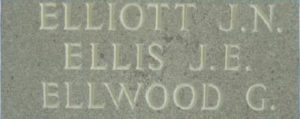
Robert Ellis, Corporal, 4190901, Royal Welch Fusiliers. Robert was born at Oswestry in 1910, the son of Edward and Susannah Ellis. He married Bertha May Broxton at Welshpool in 1937. Robert enlisted into the 7th Battalion, Royal Welch Fusiliers. The battalion was the local Territorial Army infantry battalion and was attached to 158 Brigade, 53rd (Welsh) Division. The battalion was mobilised at the outbreak of war when the Division moved to Northern Ireland to begin garrison duties. The Division then moved to Pembroke Dock, before moving again to the south of England, where it trained in readiness for the D-Day Landings. On 24 June 1944 the 7th RWF left England for Normandy, and landed at La Riviere near Ver Sur Mer. On 1 July the 7th RWF moved up to the line after dark, taking over a sector from the 10th Battalion, Highland Light Infantry, of the 15th Scottish Division in a wood south of Mondrainville. On the following day, the battalion sent out a patrol across the River Odon, but while approaching the town of Gaurus, the patrol was hit by heavy machine-gun and rifle fire and a pitched battle ensued. Robert was killed in action during the fighting that day, 2 July 1944. The 33-year-old is buried in St. Manvieu War Cemetery, Cheux, France.
Eric Gethin, Private, S/14759610, Royal Army Service Corps. Eric was born at Caersws on 15 January 1911, the son of Margaret Gethin. He married Ethel Rose Annie Finch at Clun in 1936 and the couple moved to 19, Stanley Street, Welshpool, where Eric had found work as a confectioner and cake maker. He enlisted into the Royal Army Service Corps soon after the outbreak of war and was probably attached to a Field Bakery in Palestine. Eric died in Palestine on 24 July 1945, aged 34. He is buried in Khayat Beach War Cemetery, Israel.
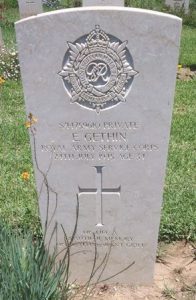
Sebert Gittins, Private, 4194699, The King’s Regiment (Liverpool). Sebert was born in Welshpool in 1920, the son of Benjamin Gittins and Mary Jane Gittins (nee Jones, formerly Pardell). He enlisted into the Royal Welch Fusiliers soon after the outbreak of war, but was transferred to the 13th Battalion, The King’s Regiment (Liverpool). The battalion was raised in October 1940 for coastal defence in England and assigned to the 208th Independent Infantry Brigade, but embarked for India in December 1941, the same month that the Japanese entered the war. The battalion was originally detailed for garrison duties but following the fall of Burma became the backbone for the newly formed Chindits, under the command of Brigadier Orde Wingate. The Chindits first operation began on 8 February 1943, when the Chindits, split into two columns, crossed the Chindwin River and advanced into Burma. Sebert was killed during a latter operation, Operation Thursday, on 9 March 1944. The 24-year-old is buried in Rangoon War Cemetery, Myanmar. His half-brother, his mother’s son from her first marriage, John Pardell, was killed in France in 1918.
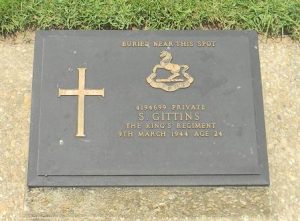
William Bernard Goddard, DFC, Flight Lieutenant, 36126, Royal Air Force. William was born in Portsmouth in 1914, the son of Harry William Goddard and Maud Emma Goddard (nee Hockley). He had enlisted into the Royal Air Force as an aircraft apprentice on 27 August 1929 and later applied for pilots training. William was commissioned as a Pilot Officer in 1938 and whilst stationed at RAF Martlesham Heath married Mary Margaret Langford, a dance teacher from Welshpool, in 1939. On 2 June 1940 William joined 235 Squadron, Royal Air Force, which had reformed at RAF Manston on 30 October 1939 as a fighter squadron, originally equipped with Fairey Battle light bombers. During February 1940, the obsolete Battle’s were replaced by Bristol Blenheim’s. On 18 November 1940, whilst on an escort operation, William engaged two He115’s. He was severely wounded in one foot by return fire, eventually losing three toes, but continued to press home his attack before getting his Blenheim and crew safely back to base. William was awarded the Distinguished Flying Cross (DFC) for his gallantry. After recovering from his wounds, he returned to the squadron. On 15 June 1941, William took off from Manston aboard Blenheim IV, Serial V5452, on an anti-shipping sortie off Norway. The Blenheim was intercepted and shot down by a German fighter that day and crashed into the sea, killing William and both his fellow crewmen. William was 27 years old when he was killed that day. He has no known grave and is commemorated on the Runnymede Memorial, Surrey. His brother, David Brian Goddard, was killed in 1945.
Ernest Godsell, Corporal, 4193262, Royal Welch Fusiliers. Ernest was born in 1919, the son of Thomas Godsell and Annie Godsell (nee Dowle), of 31, Mount Street, Welshpool. He was already serving with the 7th Battalion, Royal Welch Fusiliers, the local Territorial Army infantry battalion, when war erupted, but volunteered to serve with the newly formed No.2 Independent Company, a precursor to the army Commandos, which had been formed from volunteers from the 53rd (Welsh) Division. During the early weeks of 1940, the British had been making plans for a campaign in Norway, to support Finland in the Winter War against Russia, who at the time were Allied to Germany. When the Finns capitulated on 12 March 1940, the troops assigned to the operation were instead sent to France however, following the invasion of Norway by the Germans on 9 April, the British raised ten Special Companies, from TA Divisions, to form raiding parties, one of which being No.2 Independent Company. The Company landed at Bodø, south of Narvik as part of ‘Scissorforce’ on 14 May and immediately began operations against the Germans. Ernest was killed during an action on 26 May 1940, just prior to the force being evacuated to Scotland. The 21-year-old is buried in Saltdal Main Churchyard, Norway, one of two Welshpool men killed in the same action.
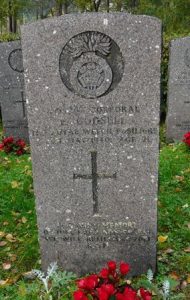
William John Griffiths, Lance Corporal, 7887295, Royal Armoured Corps. William was born in August 1920, the son of Thomas Henry Griffiths and Minnie Griffiths (nee Richards), of Welshpool. He enlisted into the army soon after the outbreak of war and was posted to the HQ, 1st Armoured Brigade, Royal Armoured Corps. William never had the chance to serve overseas, as he died at Tidworth Military Hospital, Hampshire on 11 February 1940. The body of the 19-year-old was brought home and he was buried in Christ Church Churchyard, Welshpool a week later. Later that year the 1st Armoured Brigade sailed for Egypt and fought in the Western Desert against Rommel.
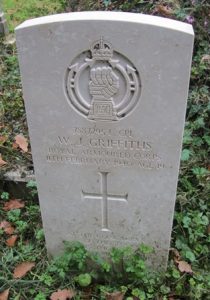
Douglas Hayden Harper, Sergeant, 1196615, Royal Air Force Volunteer Reserve. Douglas was born on 2 October 1909, the son of William and Edith Harper, of the Manor Hotel, Llandrindod Wells. He worked as a Gents Outfitter at Welshpool prior to the war and lodged at Gungrog Road. Douglas enlisted into the Royal Air Force Volunteer Reserve and after completing his training was posted to 83 Squadron, RAF. The squadron had re-formed at RAF Turnhouse in Scotland on 4 August 1936, equipped with Hawker Hinds, and on 14 March 1938 joined No 5 Group at Scampton before re-equipping with Handley Page Hampdens. The Squadron initially carried out precision daylight bombing raids but switched to night operations before re-equipping with Avro Manchester’s then Avro Lancaster’s. In August 1942, the squadron was transferred to the No 8 Group Pathfinder Force at RAF Wyton. During the night of 19 March 1943, Douglas took off from RWF Wyton aboard Lancaster I, Serial R5754, on a Pathfinding mission. The weather was poor, so just before midnight the Lancaster radioed to say it was turning back. The aircraft was never seen again, and was presumed lost on the following morning, 20 March 1943. Douglas was 32 years old when he was killed that night and is commemorated alongside his fellow crewmen on the Runnymede Memorial, Surrey.
William David Herbert Harris, Sapper, 14667781, Royal Engineers. William was the son of William Herbert Harris and Margaret Annie Harris (nee Price), of Stone Cottage, Guilsfield. He enlisted into the Royal Engineers and was selected for parachute training, before being posted to the elite 9th Airborne Squadron, Royal Engineers, which was attached to the 1st Airlanding Brigade, 1st Airborne Division. William had survived the actions which the 1st Airborne Division took part in from D-Day onwards, and after the Armistice was sent to Norway with the 9th Airborne Squadron, to act as peacekeepers, with the Division being tasked with the division was tasked with supervising the surrender of the German forces in Norway, as well as preventing the sabotage of vital military and civilian facilities. William died in Oslo on 30 May 1945, although the circumstances of his death are not known. The 21-year-old is buried in Oslo Western Civil Cemetery, Norway.
Mervyn Horatio Herbert, Squadron Leader, 86326, Royal Air Force Volunteer Reserve. Mervyn was born in London on 7 May 1904, the youngest son of George Charles Herbert, 4th Earl of Powis and of Violet Ida Eveline Herbert (nee Lane-Fox), The Countess of Powis and 16th Baroness D’arcy de Knayth, of Powis Castle, Welshpool. He married Vida Cuthbert in Westminster in 1934 and the couple had a daughter, Davina Marcia Herbert. Mervyn volunteered to serve in the Royal Air Force Volunteer Reserve and trained as a Pilot before being posted to 157 Squadron, Royal Air Force. The squadron had reformed at RAF Debden in December 1941 as a night fighter unit and became the first squadron to be equipped with the De Havilland Mosquito. On 17 December, the squadron moved to RAF Castle Camps, in Cambridgeshire, and began anti-aircraft patrols over East Anglia. On 15 March 1943, the squadron moved to RAF Bradwell Bay, in Essex, and continued in similar operations. On 23 March 1943 Mervyn was flying de Havilland DH.98 Mosquito NF Mk II, Serial DZ248, on patrol over Essex. The Mosquito contacted a friendly aircraft and was reportedly fired upon before banking and crashing into the ground at Manningtree, near Bradfield Essex, killing Mervyn and his Navigator, Pilot Officer Albert Eastwood. Mervyn was 38 years old when he was killed that day. His remains were brought home and he was buried with full military honours in Christ Church Churchyard, Welshpool. His elder brother, Percy Robert Herbert, had died in 1916 of wounds suffered on the Somme.
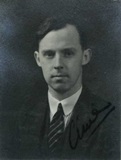
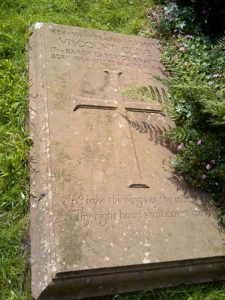
Thomas James Herbert, Private, 4193228, Argyll and Sutherland Highlanders. Thomas was born at Pontypridd in 1921, the son of Thomas James Herbert and Margaret Jane Herbert (nee Price). Following the death of his father, the family moved to 18, Clifton Street, Welshpool. Thomas enlisted into the army soon after the outbreak of war and was posted to the 8th Battalion, Argyll and Sutherland Highlanders. The battalion was a Territorial Army (TA) unit and was attached to the 154th (Highland) Infantry Brigade, 51st (Highland) Infantry Division. The Division had been annihilated during the fall of France in June 1940 and was rebuilt before embarking for North Africa. The Division fought throughout the campaign in the Western Desert, then took part in Operation Husky, the landings on Sicily. Some units from the Division then moved from Sicily to Salerno, to take part in the campaign on the Italian mainland. Thomas died in Italy on 1 December 1943. The 22-year-old is buried in Assisi War Cemetery, Italy.
Cecil Charles Hinton, Private, 4029197, Hampshire Regiment. Cecil was born on 31 March 1906, the son of Edward and Annie Hinton, of Leigh, Worcestershire. He married Phyllis Mary at Welshpool on 22 December 1928. Cecil enlisted into the army soon after the outbreak of war and was posted to the 5th Battalion, Hampshire Regiment. The battalion was a Territorial Army (TA) battalion and was attached to the 128th Infantry Brigade, 43rd (Wessex) Infantry Division. On 6 June 1942, the 128th Brigade was transferred to the 46th (North Midland) Infantry Division, and in January 1943, the division left Britain for North Africa, as part of Operation Torch, disembarking at Algiers on 17 January. The 5th Battalion saw terrible fighting at Sidi Nsir the following month, when it was attacked in overwhelming strength by German Paratroopers, elements of 10th Panzer Division and the 501st Heavy Tank Battalion. The Division continued to fight hard over the coming months until the fall of Tunis and the end of the North African campaign in May 1943. The 128th Infantry Brigade then made an assault landing at Salerno in Italy as part of British X Corps under command of US Fifth Army, led by Mark Clark in September 1943. The 5th Battalion landed in the wrong place and suffered heavy casualties. Cecil was killed at Salerno on 9 September 1943. The 38-year-old is buried in Salerno War Cemetery, Italy. His widow, Phyllis, had lost her father, Arthur Price, on the Somme in 1916.
Annie Mabel Howell-Evans, Civilian. Annie was born in Broughton, Flintshire on 29 September 1871, the daughter of Canon Reverend William Howell-Evans and Elizabeth Howell-Evans. The family later lived at Edderton Hall, Welshpool. Annie lived in London prior to the war and following the declaration of war volunteered to serve as a Telephonist in the Air Raid Precaution (ARP) headquarters at 1, Sloane Court, London. At 07.47 on Monday 3 July 1944, Annie and her sister Mary were working at 1, Sloane Court, which was at the time being used as a HQ for American servicemen, when a German V-1 ‘doodlebug’ crashed into the top end of Sloan Court, killing 65 Americans and nine civilians. Annie and her sister Mary were among the dead. Annie was 72 years old when she was killed that day and she is commemorated in the UK Book of Commemoration for Civilian casualties in Westminster Abbey. Neither Annie nor her sister Mary are commemorated on the Welshpool war memorial.
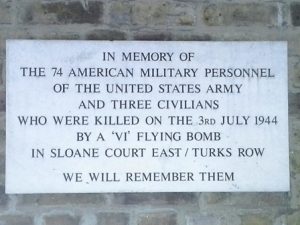
Mary Elisabeth Howell-Evans, Civilian. Mary was born at Chester on 21 June 1870, the daughter of Canon Reverend William Howell-Evans and Elizabeth Howell-Evans. The family later lived at Edderton Hall, Welshpool. Mary lived in London prior to the war and volunteered to serve with the Women’s Voluntary Service, before being posted with her sister Annie to the Air Raid Precaution (ARP) headquarters at 1, Sloane Court, London. At 07.47 on Monday 3 July 1944, Mary and Annie were working at 1, Sloane Court, which was at the time being used as a HQ for American servicemen, when a German V-1 ‘doodlebug’ crashed into the top end of Sloan Court, killing 65 Americans and nine civilians. Annie and her sister Mary were among the dead. Mary was 74 years old when she was killed that day and she is commemorated in the UK Book of Commemoration for Civilian casualties in Westminster Abbey. Neither Mary nor her sister Annie are commemorated on the Welshpool war memorial.
Eldon Wyn Hughes, Corporal, 1054384, Royal Air Force Volunteer Reserve. Eldon was born on 11 February 1917, the son of Maurice Hughes and Jane Ellen Hughes (nee Owen), of Guilsfield. He married Evelyn Lockyer, of Guilsfield, in 1940. Eldon enlisted into the Royal Air Force Volunteer Reserve and was posted to the Central Link Training School. Eldon took ill whilst stationed there and was admitted to Shenley Hospital at St. Albans. He died there of fluid on the brain on 17 January 1944. The remains of the 28-year-old were brought home for burial in Guilsfield Cemetery.
George Desmond Lloyd Humphreys, Sergeant, 1379770, Royal Air Force Volunteer Reserve. George was born at Welshpool in 1922. He enlisted into the Royal Air Force Volunteer Reserve soon after the outbreak of war and trained as a Wireless Operator/ Air Gunner. George was originally posted to 153 Squadron and was wounded during an operation on 19 November 1941 whilst flying aboard a Boulton Paul Defiant, Serial N1645, which crashed on landing and burst into flames. After recovering he was posted to 78 Squadron, Royal Air Force, which was based at RAF Croft, in County Durham. In early 1942, the squadron started to receive four-engine Handley Page Halifax’s to replace its Armstrong Whitworth Whitley’s, with conversion being completed in March that year, and flew its first operation with the Halifax against Ostend on 29 April 1942. On the night of 30/31 May 1942, 78 Squadron took part in Operation Millennium, the first 1,000 bomber raid against Cologne. The squadron moved back to RAF Middleton St. George in June 1942. On the evening of 9 August 1942 George took off from RAF Middleton St. George aboard Handley Page Halifax II, Serial W1016 as part of a large bomber group sent to destroy targets in Osnabruck. George was killed when his Halifax was lost, presumed to have crashed into the sea on the outboard journey that night, with the loss of all seven of her crew. The 20-year-old has no known grave and is commemorated on the Runnymede Memorial, Surrey.
Jones, J. This person cannot presently be identified.
John Thomas Jones, Lance Corporal, 4201131, Duke of Wellington’s (West Riding Regiment). John was born at Welshpool in 1920, the son of Edward Jones and Dorothy Jones (nee Thomas). He enlisted into the army and was posted to the 7th Battalion, Duke of Wellington’s (West Riding Regiment). The battalion was attached to the 147th Infantry Brigade, 49th (West Riding) Infantry Division and spent two years in Iceland before returning to Britain in May 1942. The Division landed in Normandy on 12 June 1944 shortly after the D-Day landings and took part in the attempts to capture the city of Caen. The Division then fought in the Second Battle of the Odon, and during the clearing the Channel Ports in Operation Astonia. After the failure of Operation Market Garden, the 7th Battalion was stationed at the Nijmegen bridgehead, around Haalderen, in late November and on 1 December was attacked by elements of the German 6th Parachute Division, which was attempting to capture the Nijmegen bridge. John was killed here during heavy fighting on 4 December 1944. The 24-year-old was Jonkerbos War Cemetery, Netherlands.
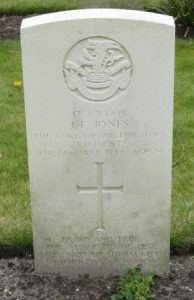
Noel George Jones, Leading Aircraftman, 614337, Royal Air Force. Noel was born in 1913, the son of Alfred Jones and Agnes Jane Jones (nee Fallows), of Hopkins Passage, Welshpool. He enlisted into the Royal Air Force at some time prior to the war and was posted to 226 Squadron, Royal Air Force. The squadron was reformed at RAF Upper Heyford as a light bomber squadron on 15 March 1937, flying Fairey Battle light bombers. It was deployed to France in 1940, suffering heavy losses before being evacuated from Brest in June 1940. The squadron then reformed at RAF Sydenham, before moving to East Anglia where it re-equipped with Douglas Havoc, Douglas Boston and North American Mitchell medium bombers, whilst carrying out attacks on German ports and anti-shipping strikes. Noel had been deployed to Northern Ireland and was killed in a motorcycle accident in Belfast on 6 November 1940. The remains of the 27-year-old were brought home and he was buried in St. Mary’s Churchyard, Welshpool.
Walter Henry Jones, Fusilier, 4189609, Royal Welch Fusiliers. Walter was born on 9 July 1913, the son of Thomas Jones and Martha Jones (nee Griffiths), of 17, Wellington Crescent, Salop Road, Welshpool. He enlisted into the 1st Battalion, Royal Welch Fusiliers as a young man and married Rosina Davies at Wrexham in 1936, whilst stationed at the barracks. The battalion embarked for France with the BEF and took up positions on the River Dyle at Ottenburg, north of Wavre, where the battalion first made contact with the attacking Germans on 14 May 1940. The forward company was subjected to intense mortar fire and a series of unsuccessful attacks throughout the following day. Meanwhile the Germans had broken through near Sedan, threatening the southern flank of the BEF, and orders for the Battalion to withdraw came on the night of 15-16 May. There was no transport available initially, so the men were forced to withdraw on foot, digging in at night in case of further attacks. Trucks arrived on 18 May and took the Battalion to Tournai on the Escaut where they held the river line under heavy fire for two days. Late on 20 May, with the German forces again threatening to outflank the BEF, the 1st RWF were told to withdraw to the area north of Béthune, where they arrived on 24 May, but the shattered battalion was then ordered to advance westward to capture four bridges over the La Bassée Canal, south of Saint-Venant. The first attack was carried out on the evening of 24 May and the battalion captured Saint-Floris but could not force their way into Saint-Venant. Fighting raged overnight and during the following days. Walter was killed at Robecq just prior to this, on 23 May 1940. The 26-year-old is buried in Robecq Communal Cemetery, France.
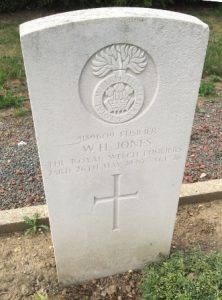
Jones, W D. This person cannot presently be identified.
William George Jones, Corporal, 16764, Royal Army Service Corps. William was born in 1901, the son of William and Sarah Jones, of Welshpool. He married Margaret Ann Jones in 1931 and the couple resided at 5, Mount Place, Welshpool. William enlisted into the Royal Army Service Corps and was attached to the 63 (Airborne) Division Composite Company, which was attached to the 6th Airborne Division. The Division took part in its first mission on D-Day, 6 June 1944, when it was responsible for securing the left flank of the Allied invasion during Operation Overlord. The division remained in Normandy for three months before being withdrawn in September. The division was then stood to in readiness to join Operation Market Garden but was not used as it had quickly become apparent that the operation had failed. The Division did not see further action until being sent to Belgium in December 1944, to help counter the German offensive in the Ardennes, during the Battle of the Bulge. The Divisions final airborne mission followed in March 1945, during the crossing of the Rhine, in Operation Varsity. William died in Germany after the successful crossing, on 16 April 1945. The 44-year-old is buried in Hanover War Cemetery, Germany.
Lambert, J. This person cannot presently be identified.
Brian Lloyd, Fusilier, 4192186, Royal Welch Fusiliers. Brian was born in Welshpool in 1910. He enlisted into the 1st Battalion, Royal Welch Fusiliers as a young man. The battalion embarked for France with the BEF and took up positions on the River Dyle at Ottenburg, north of Wavre, where the battalion first made contact with the attacking Germans on 14 May 1940. The forward company was subjected to intense mortar fire and a series of unsuccessful attacks throughout the following day. Meanwhile the Germans had broken through near Sedan, threatening the southern flank of the BEF, and orders for the Battalion to withdraw came on the night of 15-16 May. There was no transport available initially, so the men were forced to withdraw on foot, digging in at night in case of further attacks. Trucks arrived on 18 May and took the Battalion to Tournai on the Escaut where they held the river line under heavy fire for two days. Late on 20 May, with the German forces again threatening to outflank the BEF, the 1st RWF were told to withdraw to the area north of Béthune, where they arrived on 24 May, but the shattered battalion was then ordered to advance westward to capture four bridges over the La Bassée Canal, south of Saint-Venant. The first attack was carried out on the evening of 24 May and the battalion captured Saint-Floris but could not force their way into Saint-Venant, despite heavy fighting during the following days. Brian was killed at St. Floris on 30 May 1940, aged 30. He is buried in St. Floris Churchyard, France.
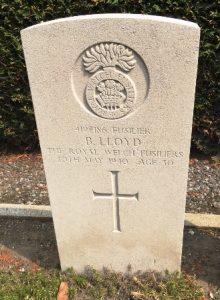
Gordon Ernest Miles, Corporal, 4191019, The King’s Regiment (Liverpool). Gordon was born in Bolton in 1914, the son of James and Annie Miles. The family moved to Welshpool some years prior to the war. Gordon married Jessie M. George at Oswestry in 1941. He enlisted into the army and was posted to the 2nd Battalion, The King’s Regiment (Liverpool). The battalion had spent five years on garrison duty in Gibraltar prior to moving to Egypt in December 1943, with the 28th Infantry Brigade to join the 4th Infantry Division. The Division moved into Italy in March 1944 to join the arduous campaign to drive the Germans out of the country and took part in the final offensive on Monte Cassino. On 18 May the Polish Brigade captured the ruins and broke the Gustav Line, and the 4th Division then joined the advance to the Trasimene Line. Gordon was killed in Italy on 13 November 1944, aged 29. He is buried in Coriano Ridge War Cemetery, Italy.
Alfred David Morris, Private, T/50522, Royal Army Service Corps. Alfred was born in 1905, the son of Alfred David Morris and Sarah Ann Morris (nee Lewis), of 4, Cumberland Place, Welshpool. He married Esther Hilda Maud Pugh at Welshpool on 26 February 1927. Alfred worked as a carpenter prior to enlisting into the Royal Army Service Corps and was posted to the 1st Base Supply Depot, in France soon after the outbreak of war. Following the launching of the German Blitzkrieg, Alfred’s unit was forced to withdraw to the French coast for evacuation. The thousands of troops who had made it to Dunkirk had already been evacuated by 6 June, whilst more had been evacuated from Boulogne, Calais, and Le Havre by 25 May. More Allied troops had managed to reach ports in other parts of France, stretching from Cherbourg down to Bayonne, so the British organised Operation Aerial, to evacuate Allied forces and civilians from western France. Alfred had managed to reach St. Nazaire with most of his unit. On 17 June 1940, the requisitioned RMS Lancastria steamed into the Loire Estuary and anchored in the Charpentier Sounds. By the afternoon Lancastria had taken aboard a huge number of evacuees, far greater than she was built to carry, with estimates running from 4,000 to 9,000 people. The Germans had already begun attacking shipping in the area, and at 15.50 Lancastria was attacked by Junkers-88 bombers and sank in less than 20 minutes, with an estimated 6,500 lives being lost. Alfred was 35 years old when he died as a result of the sinking of the Lancastria that day. His body was later recovered from the sea, and he was buried in Escoublac-La-Baule War Cemetery, France.
Morris, F. This person cannot presently be identified.
Gordon Naylor, Flight Sergeant, 1017142, Royal Air Force Volunteer Reserve. Gordon was born on 13 May 1914, the son of Arthur Naylor and Frances Millicent Naylor (nee Crossley), of 7, Edward Street, Hebden Bridge, Yorkshire. He married Barbara Hartley, of Welshpool, in Yorkshire in 1941. Gordon enlisted into the Royal Air Force Volunteer Reserve and after training as a navigator, was posted to 46 (Uganda) Squadron, Royal Air Force. The Squadron had originally been a fighter squadron equipped with Hawker Hurricane’s and had taken part in the ill-fated Norwegian campaign in 1940 before being evacuated, with all its surviving aircraft and pilots being lost during the sinking of the aircraft carrier HMS Glorious. The Squadron then played an important role in the Battle of Britain and afterwards took part in anti-convoy sweeps before being transferred to the Mediterranean, where it reformed as a night-fighter squadron, before re-equipping with Bristol Beaufighter’s and transferred to RAF Coastal Command. On 18 September 1942, Gordon took off from Idku aboard Bristol Beaufighter Mk IF, Serial X7707, bound for Cairo, with three extra men as passengers. The aircraft lost power to both engines whilst nearing Cairo and went into a spin. The pilot appears to have almost regained control of the aircraft when the tail section broke off and the Beaufighter hit the ground, killing all five men aboard. Gordon was 28 years old when he was killed that day and is buried in Alexandria (Hadra) War Memorial Cemetery, Egypt. His widow, Barbara, returned to Welshpool after the war, but Gordon is not commemorated on the Welshpool war memorial.
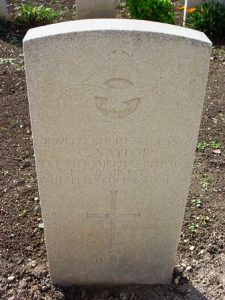
John Herbert Owen, Warrant Officer Class II, 7591141, Royal Army Ordnance Corps. John was born in Ellesmere in 1914, the son of John Edmund Owen and Lillian Owen (nee Abbott). The family later resided at Welshpool. John enlisted into the Royal Army Ordnance Corps as a young man. He married Ellen Bradley, of Stockton, Worcestershire in 1940. Following the opening of the war in the Western Desert, John was posted to Egypt, joining No 4 Base Ordnance Depot, RAOC. He died in Egypt on 2 September 1942, aged 28. John is buried in Heliopolis War Cemetery, Egypt.
Albert Ernest Preen, Fusiliers, 4193163, Royal Welch Fusiliers. Albert was born in 1915, the son of Albert Ernest Preen and Martha Preen (nee Huson), of Welshpool. He married Gwendoline Mary Humphreys at Welshpool in 1940. Albert had enlisted into the 7th Battalion, Royal Welch Fusiliers, the local Territorial Army (TA) infantry battalion, which was attached to 158 Brigade, 53rd (Welsh) Division. The battalion was mobilised at the outbreak of war when the Division moved to Northern Ireland to begin garrison duties. The Division then moved to Pembroke Dock, before moving again to the south of England, where it trained in readiness for the D-Day Landings. On 24 June 1944 the 7th RWF left England for Normandy, and landed at La Riviere near Ver Sur Mer. The Division then took part in heavy fighting over the coming weeks, as part of the effort to break-out of the Normandy beachhead, seeing heavy fighting at Évrecy, before starting the epic advance through Northern France into Belgium and Holland. On 15 September, the Division forced the crossing of the Junction Canal North of Lommel, and continued to push westwards towards Elst, between Nijmegen and Arnhem, during Operation Market Garden. On 22 October, the Division launched its famous assault on ‘s-Hertogenbosch, before continuing its advance to the German frontier. Between December 1944 and January 1945, the Division took part in the Battle of the Bulge, helping in the counterattack which helped save the Americans, who were under heavy pressure, then after the German offensive was broken, took part in heavy fighting to enter the Rhineland, taking part in Operation Plunder, the Rhine Crossings, in March 1945. Albert was killed in Germany on 13 April 1945, when the Germans counter-attacked positions recently captured by the 158th Brigade. The 29-year-old is buried in Becklingen War Cemetery, Germany.
Pugh, A. This person cannot presently be identified.
Frederick Thomas Richards, Lance Bombardier, 4080117, Royal Artillery. Frederick was born in 1917, the son of Thomas Richards and Ethel Jane Richards (nee Williams), of 50, Mount Street, Welshpool. He married Nancy Joyner Foster at Welshpool in 1939. Frederick enlisted into the Royal Artillery soon after the outbreak of war and was posted to the 11th Field Regiment, Royal Artillery. The regiment was in Iraq early in the war but in June 1942 was transferred to the Western Desert Campaign, seeing action in the Second Battle of El Alamein. The regiment then took part in the Italian campaign before being posted to Greece, as a result of the Greek Civil War. Frederick died in Greece on 1 December 1944, aged 27. He has no known grave and is commemorated on the Athens Memorial, Greece. Frederick was most likely killed when the ferry, Empire Dace, struck a mine and sank off the coast of Greece that day.
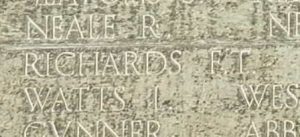
George Richard Gorton Roberts, Captain, 68150, Royal Artillery. George was born at Wrexham on 7 October 1914, the son of Reverend George Ishmael Roberts and Alice Hall Roberts (nee Gorton). His father then took up the post as Vicar of Guilsfield and the family moved to the Vicarage. George was commissioned into the Royal Artillery and had made his way up to Captain before being posted to the 1st Light Anti-Aircraft Regiment, Royal Artillery. On 13 April 1942, George’s regiment was on Salisbury Plain, but he had gone to watch a demonstration of tactical air power. A target area had been laid out on the ground for a number of RAF aircraft to carry out practise attacks and a number of spectators and dignitaries were present. The weather was fine but hazy and one of the aircraft, a Hurricane of 175 Squadron, opened fire with his cannons, missing the target area and hitting a group of spectators, killing, or mortally wounding some twenty-five of them. George was seriously wounded during the accident and was taken to hospital at Sturminster where he died of his injuries the following day, 14 April 1942. The remains of the 27-year-old were conveyed back to Guilsfield, and he was buried in Guilsfield Cemetery three days later.
John McLaren Rowlands, Lieutenant, 295342, Royal Army Service Corps. John was the son of David and Lydia Rowlands, of Welshpool. He married Kathleen Westbury Sheppard in 1939 and the couple resided at The Old Rectory, Atcham. John had studied for his MA at Oxford and was a newspaper manager and company secretary prior to the war. John enlisted into the army and in October 1943 was commissioned into the Royal Army Service Corps. He landed in Normandy at some time after the D-Day landings of 6 June 1944. John was killed in Normandy on 4 September 1944, aged 39. He was originally buried near the town of Orgeville, but in September 1946 his grave was exhumed, and he was reburied in Evreux Communal Cemetery, France.
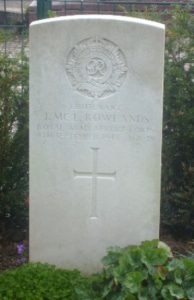
Christopher John Russell, Private, 1830028, Durham Light Infantry. Christopher was born at Craven Arms on 3 June 1907, the son of Edith Elsie Russell. He was fostered by William and Caroline Jane Turner (nee Kearn), of Laburnum Cottage, Trewern by 1911. Christopher enlisted into the Army and was posted to the 9th Battalion, Durham Light Infantry. The battalion was attached to the 151st Brigade, 50th Division, and had been in France with the BEF in 1940, taking part in the heavy fighting around Arras, before the survivors were evacuated from Dunkirk. The Division then rebuilt before embarking for North Africa, taking part in the campaign in the Western Desert against the Italians and the Afrika Korps, taking part in the successful Second Battle of El Alamein, and after this the Division was withdrawn and sent to Alexandria to refit, before training in amphibious techniques for the invasion of Sicily. The 151st brigade had been chosen as an assault brigade for the invasion of Sicily on 10 July 1943 and saw heavy fighting against an elite German paratrooper regiment. The 50th Division then received orders to return to Britain to train for the forthcoming invasion of Europe. The Division landed in the second wave on Gold Beach King sector and saw heavy fighting as it advanced inland. Following the break-out from the Falaise Pocket, the Division crossed the Seine, and took part in the advance through Northern France into Belgium and Holland over the coming weeks. By October, the Division had been moved to the ‘Island’, the low-lying ground between the Wall and the Lower Rhine north of Eindhoven and took part in the fighting to expand the bridgehead. Christopher was killed here on 4 October 1944. The 36-year-old was originally buried in a small cemetery near to when he fell, but in September 1945 the cemetery was exhumed, and all of the military burials were moved into Arnhem Oosterbeek War Cemetery, Netherlands. His foster-brother, Bertram George Turner, was killed during the Great War.
George Lewis Sapple, Fusilier, 4204905, Royal Welch Fusiliers. George was the son of George Henry Sapple and Mary Laura Sapple (nee Breeze), of 10, Whittington Passage, Welshpool. George enlisted into the army soon after the outbreak of war and was posted to the 13th Battalion, Royal Welch Fusiliers, which was a second line, or home defence, unit, attached to the 38th (Welsh) Division. George died at Portway Hospital, Weymouth on 29 April 1943, aged 23. His remains were brought home and he was buried in Christ Church Churchyard, Welshpool on 4 May.
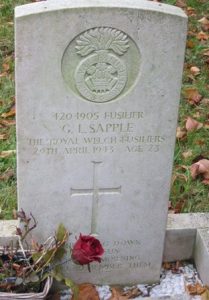
Jo Francis Cable Sterne, Lance Serjeant, 7908383, Royal Tank Regiment. Jo was born on 26 January 1917, the son of James Young Cable and Marian Monkhouse Cable (nee McKie), of Brynawel, Welshpool. He had moved to Deptford, London prior to the war after gaining work as a salesman, and married his cousin, Molly Harrie Annie Monkhouse McKie there in 1939. Jo enlisted into the Royal Tank Regiment after the outbreak of war and was posted to ‘A’ Squadron, 8th Royal Tank Regiment, which was attached to the Royal Armoured Corps. The 8th Royal Tank Regiment was attached to the 23rd Armoured Brigade, 8th Armoured Division which remained in Britain until embarking for North Africa in May 1942, to join the Eighth Army. The Division arrived in time to take part in the First Battle of El Alamein, where it was virtually annihilated. After being rebuilt, the Division fought at Alam el Halfa and then in the victorious Second Battle of El Alamein, before helping defeat Rommel in Tunisia. The 23rd Armoured Brigade then took part in the invasion of Sicily before moving into mainland Italy. Jo was killed in Italy on 14 September 1944, aged 27. He was originally buried on the battlefield, but in June 1945 his grave was exhumed, and he was reburied in Gradara War Cemetery, Italy. Jo and his wife Molly’s grandfather, John Adolph Eicholtz McKie (Alias Harry Monkhouse), was a very famous comic actor and singer in the Victorian era and had toured the world with his show, ‘A Gaiety Girl’ in the 1890’s. As a reference to this, his wife had the following epitaph added to Jo’s CWGC headstone: ‘GREAT IS OUR LOSS, TOPS “AU REVOIR” GAY’
William Frank Turner, Driver, T/4201774, Royal Army Service Corps. William was born in 1919, the son of Joshua William Turner and Harriet Jane Turner (nee Robbins), of Welshpool. His mother died just after his birth. William married Annie Myfanwy Griffiths, of Welshpool, in 1939. He enlisted into the army soon after the outbreak of war and was posted to the 490th General Transport Company, Royal Army Service Corps. William was posted to North Africa with the unit, where the Company was responsible for the transportation of supplies to the front-line troops. William died in Algeria on 28 May 1943, aged 23. He is buried in Bone War Cemetery, Annaba, Algeria.
Walter Richard Aaron Watkin, Fusilier, 4194454, Royal Welch Fusiliers. Walter was born in 1919, the son of Arthur Watkin and Annie Watkin (nee Roberts), of 6, Wellington Crescent, Welshpool. He enlisted into the 7th Battalion, Royal Welsh Fusiliers, which was the local Territorial Army (TA) infantry battalion and was attached to 158 Brigade, 53rd (Welsh) Division. The battalion was mobilised at the outbreak of war when the Division moved to Northern Ireland to begin garrison duties. The Division then moved to Pembroke Dock, before moving again to the south of England, where it trained in readiness for the D-Day Landings. On 24 June 1944 the 7th RWF left England for Normandy, and landed at La Riviere near Ver Sur Mer. The Division then took part in heavy fighting over the coming weeks, as part of the effort to break-out of the Normandy beachhead. On the night of 16 July, the 7th RWF assembled to the East of Mondrainville and prepared to launch an assault on the following morning against the heavily defended town of Évrecy. As the men advanced on the following morning, 17 July 1944, a thick mist shrouded the way, and it was hard for the men to find their bearings. Walter was killed in action during the attempted assault that morning. The 24-year-old is buried in Banneville-La-Campagne War Cemetery, France.
White, C. This person cannot presently be identified.
Robert White, MM, Sergeant, 1351788, Royal Air Force Volunteer Reserve. Robert was born at Welshpool on 8 June 1879, the son of Job White and Jane Eliza White. He had served during the Great War, gaining the award of the Military Medal, for Bravery in the Field, before returning to civilian life and becoming a postman. Robert married Margaret Lee at Wellington, Shropshire in 1933. He enlisted into the Royal Air Force Volunteer Reserve soon after the outbreak of the Second World War. Robert died of heart failure at Chelveston, Lancashire on 28 April 1942, aged 62. His remains were brought home and he was buried in Christ Church Churchyard, Welshpool. Robert is not commemorated on the Welshpool war memorial unless the naming of C. White on the memorial is an error?
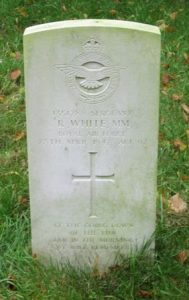
James Charles Williams, Gunner, 4191183, Royal Artillery. James was born in 1916, the son of David Williams and Ada Williams (nee Morris), of Welshpool. He married Joan Sybil Parry, a dressmaker from Newtown, in 1941. James enlisted into the Royal Artillery and was posted to the 40th Light Anti-Aircraft Regiment, Royal Artillery. The unit was a Territorial Army (TA) unit, which was attached to the 51st (Highland) Division and saw much action during the Blitz before embarking for North Africa in August 1942. The unit then saw further action at El Alamein and in Tunisia before taking part in the invasion of Sicily and in November 1943 was withdrawn from Sicily and returned to Britain to train in preparation for the forthcoming D-Day landings. The 51st Division landed in Normandy on 7 June 1944 and took part in the break-out from the Normandy beachhead and the subsequent drive through France into Belgium and Holland over the coming months. James was killed just after the 51st Division had crossed into the Reichswald, on 9 March 1945, aged 28. He is buried in Swartbroek Churchyard, Netherlands.
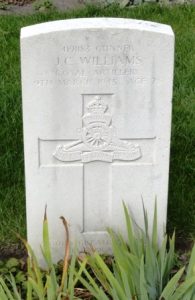
David Owen Wynn-Owen, Ordinary Seaman, D/JX 284003, Royal Navy. David was born at Wrexham on 6 April 1923, the son of Hywel Wynn-Owen and Heulwen Mansergh Wynn-Owen (nee Thomas). The family then moved to the Midland Bank, Berriew Street, Welshpool after Hywel had gained the position of Bank Manager. David enlisted into the Royal Navy and after completing his training was posted aboard the Tribal-class destroyer HMS Matabele. She had spent the early part of the war carrying out duties including the interception of German shipping as well as anti-submarine patrols. She was refitted and modified at Devonport early in 1940 before returning to her duties in home waters. In January 1942, Matabele was steaming from Iceland for Murmansk with HMS Somali, as a destroyer screen for the cruiser Trinidad on Convoy PQ 8. The convoy came under attack from the German submarine U-454 on 17 January 1942, just one day from Murmansk and suffered several losses throughout the afternoon. At about 22.10 that night Matabele was struck by a torpedo from U-454 which detonated her magazine, causing the doomed destroyer to sink in minutes. Some 236 men were lost as a result of the sinking that night, including David. Only two men survived. David was 18 years old when he died on 17 January 1942. He has no known grave and is commemorated on the Plymouth Naval Memorial, Devon.